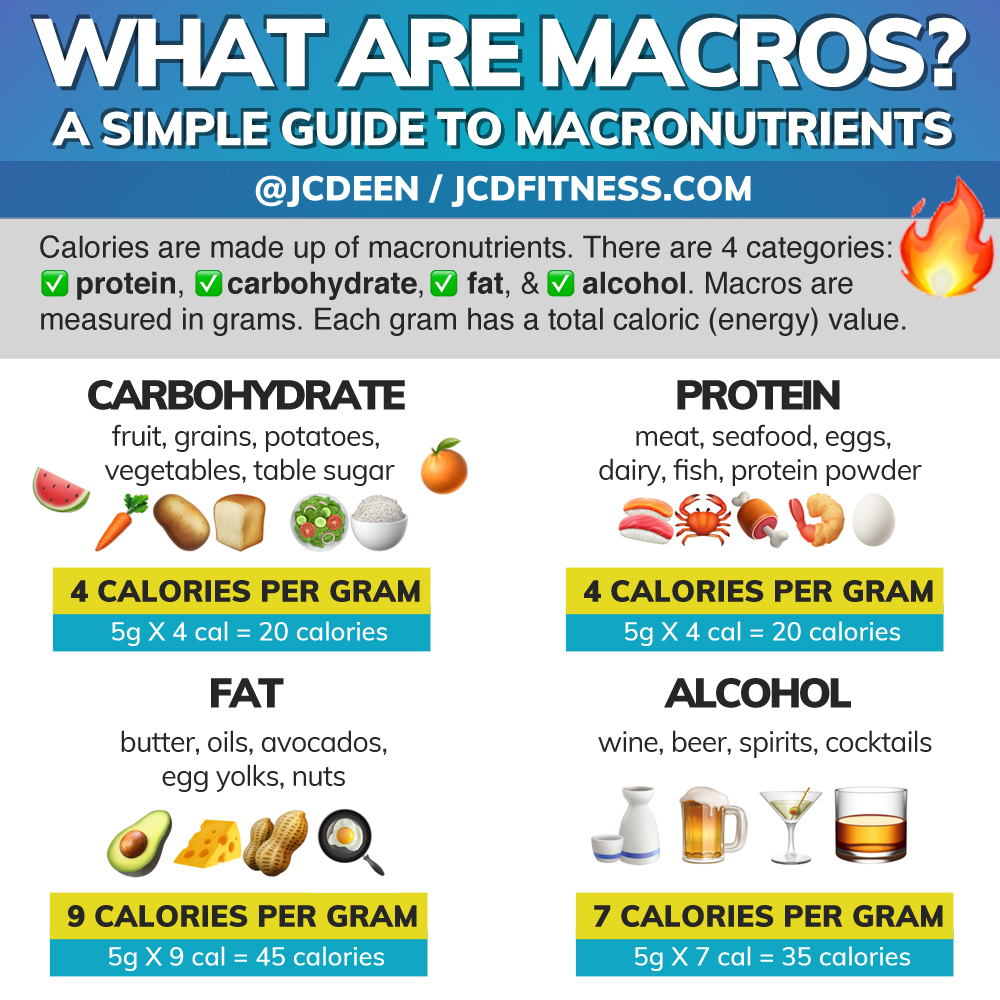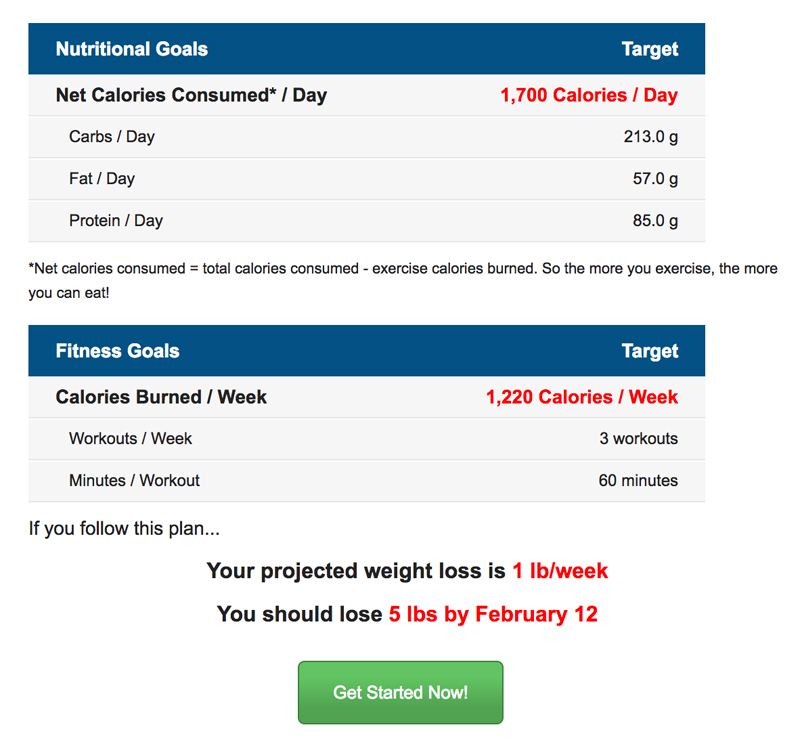
‘Macros’ are short for macronutrients on the internet amongst those who are concerned about strategically shaping their bodies through carefully crafted exercise and resistance training protocols.
Today, in this short article, we’re going to answer the question, ‘what are macros?’
What are macros?
Macros (macronutrients) are what makes up the food we eat each day in order to live and function. Macro means large, and micro means small.
If you’ve heard the term, micronutrients, you’ve probably heard the term, macronutrients.
Macronutrients are needed in large amounts by the body, while micronutrients are needed in much smaller amounts.
Macronutrients are made up of four categories: protein, carbohydrates, fat, and alcohol.
Micronutrients can be found inside of those macros above. These are also known as vitamins and minerals and there is a wide variety of these that are needed for proper function in the body.
Each macronutrient contains a certain amount of calories per gram.
1 gram of protein = 4 calories
1 gram of carbohydrate = 4 calories
1 gram of fat = 9 calories
1 gram of alcohol = 7 calories
Let’s get into each macronutrient and their importance.
Protein

Protein is responsible for many functions in the body, but for this guide, we’ll focus mostly on how it helps us repair muscle tissue that’s been broken down from hard resistance training.
When your body undergoes muscle repair, turnover, and thus, growth, this is a physiological process called anabolism, which is why protein can be considered anabolic.
What’s The Ideal Amount To Consume?
The research suggests a range of .8g – 1.5g per pound of body weight. However, depending on your preferences for protein intake, trying to consume 1.5g per pound can be quite the challenging (and sometimes expensive) task. It can also make it harder to get other macros that are equally as important as protein.
For most people, the recommendation of 1 gram per pound of body weight is likely ideal for positively changing your body composition. If you’re very overweight (with more than 50 pounds to lose), then multiplying your body weight by .7 – .8 is a great way to calculate your intake. Read more about the science of how much protein you need per day.
While protein is important for muscle gain, maintenance, and repair, eating above and beyond the above recommendations for daily intake will not magically make your muscles grow faster nor will it aid in faster fat loss. More is not always better when it comes to protein.
Quality Protein Sources:
- Lean chicken, beef, lamb, turkey, pork
- Fresh fish, canned fish
- Deli meat (turkey and ham)
- Beef broth (gelatin)
- Tendon meat (from the connective tissue of beef, chicken, lamb, pork)
- Dairy (milk, cheese, yogurt)
- Eggs
If you need some more protein-heavy food ideas for your intake, read how to eat more protein.
Carbohydrate

To get technical, the body can survive on zero carbohydrates, but this is not ideal. In this case, the body will break down the protein you’ve eaten, as well as your muscles, to use as glucose.
Carbohydrates are stored in your liver and in your muscles. The stored carbohydrates are known as glycogen, and this is the primary fuel source for your high-intensity activities (hello weight training and sprints).
What’s The Ideal Amount To Consume?
There is no ideal amount for every single person, but I like to see a minimum of 1 gram per pound of body weight at all times. And some people have been known to consume upwards of 500+ grams per day when being active and training regularly.
This is largely dependent on your body size, activity levels, and your primary form of exercise.
A good range to think about is somewhere between 1 and 3 multiplied your body weight depending on the goal (fat loss, muscle gain, maintenance) and activity levels. Carbohydrates are also a precursor to thyroid hormone production, so a diet too low in carbohydrates can spell disaster for thyroid and metabolic health.
Obviously, someone with a high activity level will require more energy than someone who sits all day, so this is the reason for such wide range of carbohydrates.
Quality Carbohydrate Sources:
- Potatoes (all varieties)
- Rice (brown and white)
- Pasta
- Fruit
- Fresh fruit juice (no concentrates)
- All vegetables
- Bread
- Grains
Read Don’t Fall For The Low-Carb Trap to learn more about why low-carb diets aren’t the best solution for most people.
Popular question: “Should fiber be counted toward or subtracted from macro totals?”
Since fiber is not fully digested, some believe you shouldn’t account for it, but for ease of tracking, always account for it when tracking because your intake can vary from day to day and it’s probably not worth worrying about in the end.
Fat

Fat also helps with hormone production (testosterone for men, progesterone for women), so a diet too low in fat could be detrimental to your hormonal health.
What’s The Ideal Amount To Consume?
It will depend on the individual and their needs, but someone with a higher energy expenditure from more activity will be able to eat more fat due to the demands on their body from an energy balance perspective.
In terms of a range, anywhere from 15-25% of your overall caloric intake is probably ideal. This allows for enough fat in the diet to cover vitamin absorption and hormone production needs, as well as makes your food taste good.
It’s often a misconception that eating a lot of fat will make you fat. But eating lots of fat (or sugar) will not make you fat if you’re maintaining a caloric balance, or in a deficit. I explain more in this article: Is Sugar Bad For You And Does It Make You Fat?
Quality Fat Sources:
- Coconut oil
- Palm oil
- Olive oil
- Fats (beef, lamb) from grass fed animals
- Avocado
- Egg yolks
- Dark chocolate
To get a full nutritional education on protein, carbohydrate, and fat, I highly recommend picking up a copy of The First Diet by Sean Bissell. You can read my review here.
Alcohol

Here’s a quick guide on a number of calories in your favorite beverages (source):
- Any hard liquor (1 shot) + diet soda (1 ounce serving = 80 calories)
- Wine (5 ounces serving = 120 calories)
- Cider / Beer (12 ounce serving = 180-200 calories)
*but even then, it’s not needed.
Percentages and Body weight recommendations (what’s better)
There are a TON of fat loss, muscle gain, and maintenance calculators on the web. There are also a ton of BMR (basal metabolic rate, which means what you burn at complete rest) and activity calculators online to help you establish a starting point.
Regardless of what you use, there’s one thing you must know.
All of these are good estimates and starting points.
Oftentimes, these calculators will spit out a caloric recommendation based on your body weight. And the macronutrient percentages it recommends will often be in percentages, as opposed to recommendations based on your total body weight, or calculated lean body mass.
When you’re determining your total caloric intake, it’s almost always better to use your current body weight for protein and fat recommendations, rather than relying on percentages.
For instance, if you’re a large man of 200 pounds and you input your info into a calculator and it spits out the following for a fat loss diet:
2000 calories
20% from protein
50% from carbohydrates
30% from fat
For number’s sake, this would come out to be the following:
20% (protein recommendation) of 2000 calories = 400 calories. 400/4 = 100
50% (carb recommendation) of 2000 calories = 1000 calories. 1000/4 = 250
30% (protein recommendation) of 2000 calories = 600 calories. 600/9 = 66
Total Macro Layout:
100g protein
250g carbs
66g fat
In this case, this is an abysmal protein recommendation for an exercising person, especially someone who is weight training.
This is where percentages fail. And to put it into perspective. I ran my numbers really quickly in the MyFitnessPal app to generate a so-called ‘plan’ for giving me a starting point for fat loss… This is what it spit out:
Not only are the calorie recommendations low, the protein intake is going to be very suboptimal if I want to maintain deez gainz.
Their system is largely percentage/algorithm based, so I do not recommend relying on these types of calculators for determining macronutrient needs.
Here’s what you should do if you want optimal fat loss (maintaining muscle and losing fat):
- Determine your total maintenance calorie needs.
- Set a moderate deficit of 300-500 calories less per day.
- Set your protein intake based on your body weight (how much protein do you need?)
- Fat can be set to around 20-25% of your total calories, or you can determine your fat intake by multiplying your bodyweight (in pounds) by 20-40% to get a total number in grams.
To read more about how to properly setup macros for fat loss, read this: how to implement a practical weight loss plan.
Should you count calories or macros?
Ideally, you should track macros because your macros make up your calories. End of story. In the end, as long as you create a negative energy balance, that’s all that matters.
Read my guide on How To Count Macros for an in-depth explanation.
What About IIFYM?
If It Fits Your Macros is a way of being extremely flexible with your eating as opposed to the rigidity that often comes with fat loss diets.
IIFYM, in a nutshell:
The basic understanding of IIFYM (if it fits your macros) is that you can essentially eat any foods you’d like as long as it falls within your daily caloric needs, but more precisely, as long as those foods fall within your macronutrient goals. The idea is regardless of losing fat, building muscle, or maintaining body composition, as long as you hit your macros, it doesn’t matter if it’s from pizza and pop tarts, or oatmeal and boiled chicken.
In the end, there are people losing body fat eating junk food, and people doing similarly well on the most boring diets known to man. Fish and rice cakes, anyone?
IIFYM is nothing special. It’s just another way of having foods you enjoy while still maintaining a caloric balance of your choosing. In fact, I’m it’s pretty common that IIFYM diehards are likely lying to you about their intake.
“Do I need to eat clean to reach my goals?”
For the most part, no. Clean eating is an incredibly odd way of viewing food and when I wrote about it long ago, I got a lot of heat for it.
Here’s what you need to know.
We follow the 85% rule here, which means 85% is all that’s needed to successfully reach your goals.
You need to be consistent with training 85% of the time. This means you’re not always going to be perfect. You’re going to miss sessions every now and again because you get sick, or you have a late meeting, or you go on vacation.
The same goes for nutrition. I’m a huge proponent of maintaining a diet full of whole foods, but you should definitely treat yourself now and again. So, 85% of the time, make sure you eat a variety of whole foods to reach your vitamin, mineral, and energy requirements, and 15% of the time, enjoy whatever you like — anything goes. It could be ice cream, cake, pop tarts, chips, soda, candy, whatever you want.
So whether you want to eat clean, follow Paleo, be a vegetarian, or follow The First Diet guidelines (my preferred method), if you adhere to the 85% rule, you can’t go wrong.
And easy way to guide yourself through the question of what’s healthy and what’s not, ask yourself this question: ‘was this food available, as-is, when my great grandparents were young?’
If you answer ‘yes,’ then it’s probably a solid choice for regular consumption. If you answer ‘no,’ then it might be best left for the occasional treat here and there (follow the 85% rule).
Some examples of foods that were available when our grandparents were young:
- All fruits and vegetables (juices included)
- Animal products (muscle and organ meat, dairy products)
- Grains, potatoes, rice
- Saturated/monounsaturated oils (coconut, olive, palm oils)
Some examples of foods that weren’t available when our grandparents were young:
- Anything packaged with a long shelf life (cookies, cakes, pastries, etc)
- Readily available frying oils (mostly hydrogenated oils)
- Deep fryer foods
- anything you’d get at a fast food restaurant
- Soft drinks
- Overly processed sweets (candy) and candy bars (lots of ingredients and filler)
Now that you know what macros are, it’s time to learn how to count them, that’s if you’re interested in tracking your intake for better body composition. Be sure to check out my full guide, How To Count Macros and let me know what you think.


1 thought on “What Are Macros? — What To Know About Macronutrients”
Comments are closed.